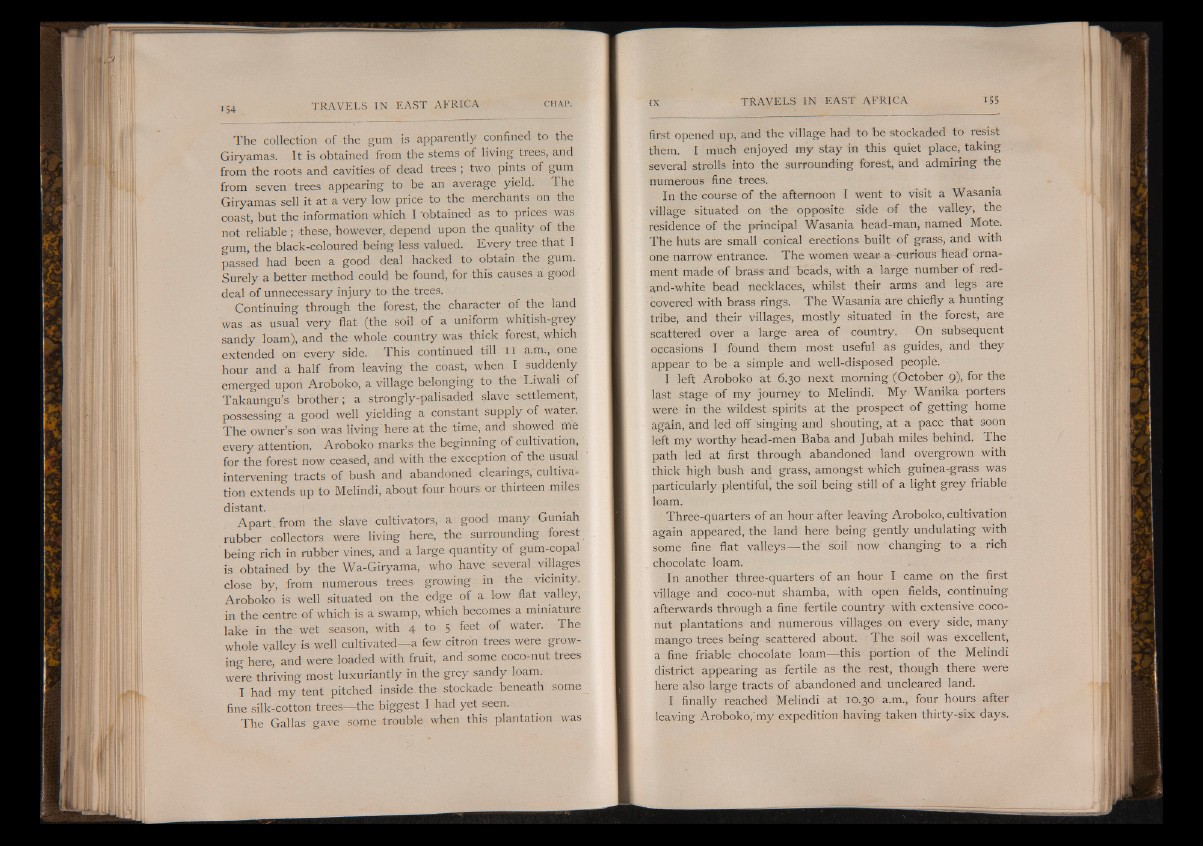
The collection of the gum is apparently confined to the
Giryamas. It is obtained from the stems of living trees, and
from the roots and cavities of dead trees; two pints of gum
from seven trees appearing to be an average yield. The
Giryamas sell it at a very low price to the merchants on the
coast, but the information which I 'obtained as to prices was
not reliable; these, however, depend upon the quality of the
gum, the black-coloured being less valued. Every tree that I
passed had been a good deal hacked to obtain the gum.
Surely a better method could be found, for this causes a good
deal of unnecessary injury to the trees.
Continuing through the forest, the character of the land
was as usual very flat (the soil of a uniform whitish-grey
sandy loam), and the whole country was thick forest, which
extended on- every side. This continued till 11 a.m., one
hour and a half from leaving the coast, when I suddenly
emerged upon Aroboko, a village belonging to the Liwali of
Takaungu’s brother; a strongly-palisaded slave settlement,
possessing a good well yielding a constant supply of water.
The owner’s son was living here at the time, and showed me
every attention. Aroboko marks the beginning of cultivation,
for the forest now ceased, and with the exception of the usual
intervening tracts of bush and abandoned clearings, cultivation
extends up to Melindi, about four hours or thirteen miles
distant. .
Apart, from the slave cultivators, a good many Guniah
rubber collectors were living here, the surrounding forest
being rich in rubber vines, and a large quantity of gum-copal
is obtained by the Wa-Giryama, who have several villages
close by, from numerous trees growing in the vicinity.
Aroboko is well situated on the edge of a low flat valley,
in the centre of which is a swamp, which becomes a miniature
lake in the wet season, with 4 to 5 feet of water. The
whole valley is well cultivated— a few citron trees were growing
here, and were loaded with fruit, and some coco-nut trees
were thriving most luxuriantly in the grey sandy loam.
I had my tent pitched inside, the stockade beneath some
fine silk-cotton trees— the biggest I had yet seen.
The Gallas gave some trouble when this plantation was
first opened up, and the village had to be stockaded to resist
them. I much enjoyed my stay in this quiet place, taking
several strolls into the surrounding forest, and admiring the
numerous fine trees.
In the course of the afternoon I went to visit a Wasania
village situated on the opposite side of the valley, the
residence of the principal Wasania head-man, named Mote.
The huts are small conical erections built of grass, and with
one narrow entrance. The women wear a curious head ornament
made of brass and beads, with a large number of red-
and-white bead necklaces, whilst their arms and legs are
covered with brass rings. The Wasania are chiefly a hunting
tribe, and their villages, mostly situated in the forest, are
scattered over a large area of country. On subsequent
occasions I found them most useful as guides, and they
appear to be a simple and well-disposed people.
I left Aroboko at 6.30 next morning (October 9), for the
last stage of my journey to Melindi. My Wanika porters
were in the wildest spirits at the prospect of getting home
again, and led off singing and shouting, at a pace that soon
left my worthy head-men Baba and Jubah miles behind. The
path led at first through abandoned land overgrown with
thick high bush and grass, amongst which guinea-grass was
particularly plentiful, the soil being still of a light grey friable
loam.
Three-quarters of an hour after leaving Aroboko, cultivation
again appeared, the land here being gently undulating with
some fine flat valleys— the soil now changing to a rich
chocolate loam.
In another three-quarters of an hour I came on the first
village and coco-nut shamba, with open fields, continuing
afterwards through a fine fertile country with extensive coconut
plantations and numerous villages.on every side, many
mango trees being scattered about. The soil was excellent,
a fine friable chocolate loam— this portion of the Melindi
district appearing as fertile as the rest, though there were
here also large tracts of abandoned and uncleared land.
I finally reached Melindi at 10.30 a.m., four hours after
leaving Aroboko, my expedition having taken thirty-six days.